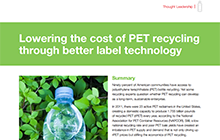The high cost of PET recycling
Bottles made from polyethylene terephthalate (PET) plastic are the leading source of plastic for recycling and remanufacturing. Yet landfills are still the final destination for many plastic water and soda bottles. Why? A major contributor is the high cost currently associated with PET recycling and thermoform recycling.
Demand for recycled PET (rPET) is outpacing supply, which increases the pressure on plastics reclaimers to yield a greater amount of reclaimed material. Yet problematic elements in the PET recycling process make it difficult for reclaimers to produce high-quality rPET flakes for remanufacturing. Two elements affecting high-quality rPET are full-wrap shrink sleeve and pressure-sensitive (PS) labels, which are popular with brand owners because of shelf appeal, adhesion properties and unique design features.
The use of full-wrap shrink sleeve and PS labels adds significant costs for reclaimers. Due to bleeding ink, adhesive residue and, in the case of full-wrap shrink sleeves, impeding automated sorting equipment, PS and shrink labels frequently contaminate rPET flakes. Contamination reduces the quality of the rPET flake so that it cannot be used in food-grade applications.
Dealing with these labels also requires additional effort on the part of reclaimers, such as multiple sorting stations, to ensure that none of these contaminants enters the recycling stream.
When label and packaging materials disrupt the recycling process, it affects the amount and quality of rPET. This in turn negatively impacts the economics of recycling for both reclaimers and brand owners who invest in recycled-content packaging.
Educating brands about PET recycling friendly labels
Today, more big brands are looking for ways to green their supply chain through bottle-to-bottle applications, but are struggling to adopt technologies that could help. For example, shrink sleeves are a favorite of brand owners due to their “shrunk on” look and ability to adhere to odd-shaped containers. But many brands don’t recognize the issues these labels cause, so label converters continue to use them. The same goes for PS labels, which have good adhesive properties but high contamination risks.
One way the APR is helping to move plastics bottle designers and fabricators away from these problematic options is by offering regularly updated guidelines on how they can produce recyclable PET packaging solutions.
APR Design™ Guide for Plastics Recyclability
- Using fewer label materials on PET plastic bottles
- Exposing a significant portion of the PET plastic bottle
- Using label materials with a specific gravity less than 1.0
- Choosing label materials that are recycle friendly, including inks, facestock, adhesives and coatings
- Using label materials that easily detach during processing
The APR guidelines gives label converters a basis on which to develop solutions that help brands achieve their sustainability goals. As more brands begin to request and invest in sustainable packaging solutions, converters can deliver options that address compatibility in the recycling stream, along with performance and marketability.
Balancing recyclability and marketability
If contamination in the PET recycling stream continues to escalate, it will be increasingly difficult to balance the supply and demand for rPET material, NAPCOR warns. Yet some brand owners may not be aware of how their packaging design choices contribute to contamination, directly impacting the availability of high-quality rPET. Others need help identifying label materials that are compatible with both recycling and their business needs.
By developing and offering technologies that meet the APR’s guidelines, label converters and designers can help brands find plastics packaging solutions that work for specific product applications and are also compatible with the broadest range of existing recycling processes, whether it’s a floating label or an easily detachable label adhesive. These solutions empower recyclers to produce cleaner, quality rPET for remanufacturing so that more gets recycled and recovered for renewable plastic bottle products.
It also benefits brand owners to support efficient PET recycling, as more companies seek sustainable and cost-effective solutions for their products. Through choosing label and packaging materials that improve utilization in PET recycling, brand owners play an important role in making recycling a viable, profitable industry for years to come.



